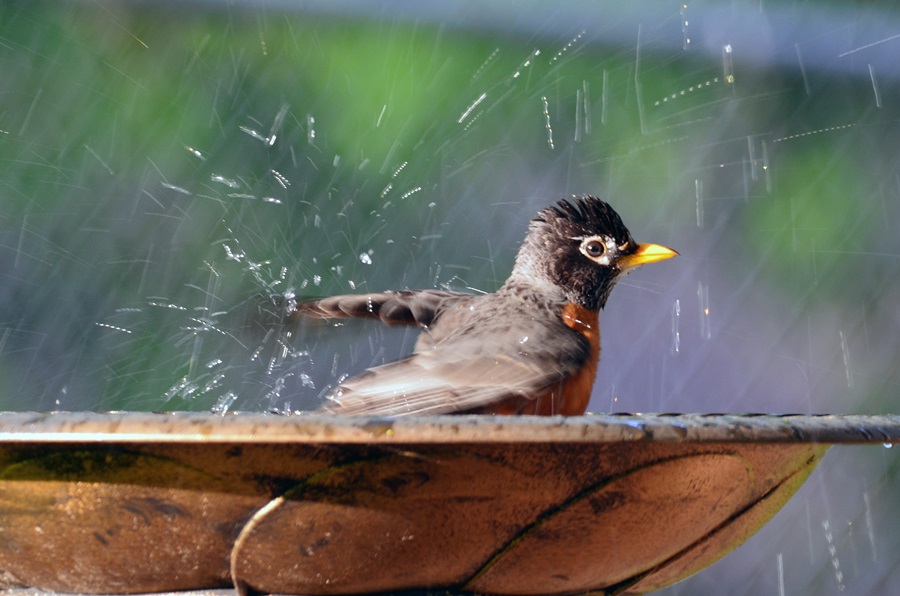The beginning of August is just about the hottest point of the year on Cape Cod. This year has already proved to be a warm one: a mid-June heat dome kept temperatures hot across the Northeast, and daily highs on the Outer Cape stayed above 80° F for much of July. Globally, a report by the European Union’s Copernicus Climate Change Service found that July 21 was the hottest day recorded in Earth’s history.
As we seek relief from shade, dips in ponds, and breezes off the Atlantic Ocean, I have sometimes wondered what birds do to stay cool.
It turns out that, in some respects, birds are uniquely poised to suffer in high temperatures. Birds run hot: one study on a chickadee relative known as the marsh tit found that these birds’ internal temperatures can exceed 113° F.
Worse still, birds can’t submerge themselves in water like amphibians and turtles do, or burrow into the ground like small mammals and snakes. Instead, they rely on more subtle adaptations to keep themselves from overheating.
Of course, birds can use the same methods that we use to stay cool. They’ll often hide in the shade during the day and will gladly splash in a puddle or birdbath. If you are keen on attracting birds during the summer, you can’t go wrong with a birdbath. (A feeder isn’t a big draw right now: most garden birds eat insects instead of seeds in the summer to provide better nourishment for their young.)

Birdbaths allow birds to get water to their skin, where it can draw some heat away from their bodies. This is especially helpful for our year-round species like cardinals and blue jays, whose coats of feathers provide insulation in the winter but risk being too warm in the summer.
Birds will also puff up their feathers to allow air to flow to the skin beneath and some body heat. Birds like herons might also droop their wings to allow more air to flow past the more lightly feathered patches of skin around their underwings. Some birds pant to allow heat to dissipate out of their mouths.
Some species also engage in a behavior known as gular fluttering, where a bird opens its bill and rapidly flexes its throat muscles, which vibrates the throat and causes air to quickly flow in and out of the bird’s mouth. It’s like an advanced version of panting. Owls, doves, cuckoos, and pelicans all do this when they’re hot enough.
You can see this behavior in action by watching the roosting cormorants at the breakwater in Provincetown. There, you might spot a few birds with their mouths agape and orange throat pouches rippling as they try to stay cool.
Many birds dissipate heat through their beaks. Saltmarsh and seaside sparrows in warmer climates have larger bills, likely to allow these birds to shed more of their body heat. And song sparrows living in dry coastal dunes have larger bills than those in wetter environments, allowing them to shed heat more quickly.
Hummingbirds, which burn huge amounts of energy, have their ways of staying cool, too. A study on the Calliope, North America’s smallest hummingbird, found that it dissipates heat by drooping its feet and raising the temperatures around its face and underwings, essentially allowing its eyes and wingpits to broil so that the rest of its body stays cool.
Perhaps no bird has a stranger solution to self-cooling than the vulture. When temperatures get really hot, these birds will poop on their own legs, and as the poo dries, the evaporation cools them the same way that drying sweat might. If it works, who are we to judge?
Thanks to these adaptations, the birds we’re familiar with seem to be surviving the hottest heat waves Cape Cod has had to offer. But these behaviors apparently do not come without consequences.
The black-and-white grackle-like bird known as the southern pied babbler lives in the dry savanna of southern Africa, one of the hottest places on Earth. It is adapted to these conditions and performs all kinds of heat-dissipation behaviors. But these behaviors take time — and it’s time that the birds can’t spend foraging. As a result, they eat less as temperatures rise. A 2012 study published in Global Change Biology found that when outside temperatures reach 96° F, the babblers are not able to gather enough food during the day to make up for the weight they lose at night. In hot temperatures, these birds literally waste away.
No similar study has been done on our local birds, but there’s already evidence that they are responding to rising temperatures. Climate change is pushing bird ranges north at an average rate of about a mile per year, according to research presented in the Proceedings of the National Academy of Sciences in April 2024.
I’ve written before about some backyard birds, like cardinals and Carolina wrens, that have arrived here in the last 100 years. We’ve been lucky so far: we haven’t seen too many birds departing because of climate change.
But we are at the southern edge of some birds’ breeding ranges. The cryptic brown creepers and boisterous red-breasted nuthatches that breed in the pine forests of the National Seashore don’t breed much further south along the coast than here — in New Jersey and Maryland, you have to go up into the mountains to find them. Fifty years from now, when our heat waves are much hotter than they are now, will these birds still be with us in the height of summer? Or will the toll that heat takes be too much?



